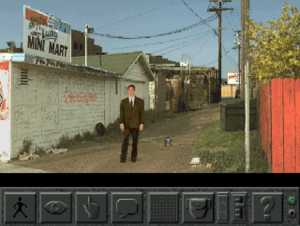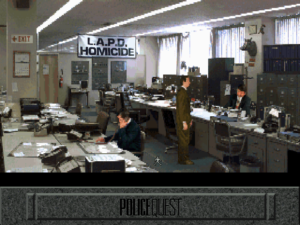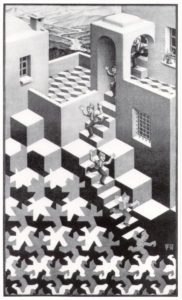PQ4: Story
I haven’t said much about the story of Police Quest 4 yet. Let’s rectify that.
The main plot is a hunt for a serial killer. The victims, including two cops, are found at accelerating intervals, naked and mutilated, with signs of poisoning. The specific poison is not identified by autopsy — every time a new victim is found, you get to hear the coroner make excuses for this, asserting that there are thousands of poisons, and tests for only a few of them. And in general, lab results tend to be promised and then forgotten about: “We’re analyzing the fibers found on the body”, you’re told, and that’s the last you hear about it. Obvious suspects crop up, and you find evidence pointing at them, only to have it not pan out, leaving you at square one until a new body shows up. Overall, it has a strong sense of futility, although that’s probably not what the author intended.
Although maybe it is. Some parts of the game seem like cries of frustration — the recurring annoyance with the media, for example, personified by a TV reporter who blames the police for not protecting the public. Similarly, one of the bodies is found on the grounds of a famous rapper’s mansion (the author clearly doesn’t get rap, and the player is expected to not get it too), and the rapper actually accuses the cops of dumping the body there in order to ruin his reputation and hurt his sales. (A strange thing to say, considering the lengths that some rappers have gone to in order to cultivate a criminal reputation.) And of course your boss has harsh words for you every time someone else complains about you doing your job. Everyone has it in for you, even though everything you do is really for their own good. It’s a little like an Ayn Rand novel in that respect, except with a greater sense of social responsibility. If anything in the game is a deliberate expression of Daryl Gates’ conscious worldview, it’s this sense of persecution.
And yet, when the player character has his “I’m through with this crap” moment, it’s not a reaction to the hate, but to the bureaucracy. Which is strange for a game that so fetishizes paperwork, but I’m assuming that this is simply inherited from the previous Police Quest games, and not part of the author’s message. At one point, you need some DNA evidence analyzed, while the room where you’d normally check in evidence at HQ is closed. And so you have to take it directly to the morgue, where the PC delivers an impassioned speech about how we can’t afford these delays while the killer could strike again at any moment. The game frequently gates stuff by closing other offices arbitrarily, but in this one instance, it seems to be aware of how frustrating this is. 1You actually have to wait for elevators in the HQ building. At first I thought this made some sense as a way to encourage you to spend most of your time in the field and only come back to HQ when you have something specific to do there, and that may have been the intention, but the unpredictability of where you have to go in order to advance the story interferes with any such planning on the player’s part. At any rate, the only apparent result is a reprimand for not following procedure. As usual, evidence submitted for analysis is never mentioned again.
I half-suspect that I’m missing out on some way of getting information that the game expects me to have — particularly when I’m asked at one point whether the killer is a man or a woman, and have to answer on the basis of no hard evidence. But then, this is a game that generally makes progress contingent on receiving exposition, so I doubt it. More likely there were infodumps cut in order to meet a deadline.
Meanwhile, there are other crimes, including a neo-nazi hate criminal at one point that seems plainly included as a doomed-to-failure attempt to stave off allegations of racism on the part of the author. The initial crime scene had a second body, a kid riddled with bullets in a dumpster, which turned out to be completely unrelated to the serial killings — apparently murder victims are so dense in Los Angeles that good body-dumping spots have to be shared. Back in the original Police Quest, the crime wave threatening the sleepy city of Lytton was ultimately the product of one man, and arresting him meant there was hope that things would go back to normal. There is no such hope here. LA, in this game, is irreparably steeped in violence — another facet of that sense of futility I mentioned.
I haven’t quite reached the end of the game, but I expect that I’ll arrest the serial killer after a dramatic confrontation. Afterwards, the author has a choice: the wish-fulfillment route, with the PC hailed as a hero and even that TV reporter changing her tune, or the darker and more thematic route, where even after saving lives nothing really changes. But I submit that it would be more in line with the game so far if the PC is the next victim. To be tied up like the previous victims would be the ultimate expression of his powerlessness in the messed-up world, and to die without solving the case would be the culmination of the repeated failures to pin it on anyone throughout the game. I doubt that Sierra would have the courage to do this, but it would be very noir, and make me re-evaluate a lot of what I’ve already seen.
| ↑1 | You actually have to wait for elevators in the HQ building. At first I thought this made some sense as a way to encourage you to spend most of your time in the field and only come back to HQ when you have something specific to do there, and that may have been the intention, but the unpredictability of where you have to go in order to advance the story interferes with any such planning on the player’s part. |
|---|
 Comments(0)
Comments(0)

